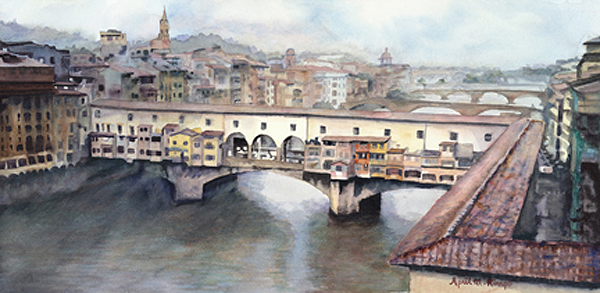It’s been said that there are about 34 towns in 25 states named Springfield. Five of them are in Wisconsin and at least one is in Massachusetts. The latter is singular, because April Rimpo grew up there close to her grandparent’s home where paintings made by her grandfather graced the walls. When April drew pictures as a child, copying cartoon figures and exploring what the pencil could do, she received positive feedback from the family and teachers.
In high school April worked part time in her father’s metal name plate company to earn spending money and enough cash to take lessons from a nearby artist. The first few lessons always emphasized value studies in black and white media. Like artist Harley Brown, her instructor Paul Scopp believed, “Value drawings are one of the artist's best friends.” When students had that under their belts, they moved on to creating color images with any medium they desired. April selected colored pencil and oils. The genial atmosphere in the class was encouraging to the students as they worked at their own pace.
Being an adventurous person, April moved to Portland, Oregon after high school and was a math major at Reed College. Quite a switch from art, but something she had always enjoyed and done well with, no doubt inherited from her mother who had completed college with a double major in physics and math. An interest in anthropology rounded out her liberal arts education. After two years at Reed, she moved back to Springfield and enrolled in Western New England College, studying electrical engineering, an avenue of applied math, in evening classes after work. Seven years later a bachelor’s degree was in her possession, and that paved the way for a 32-year career at Motorola and then General Dynamics.
Her electrical engineering job began in Arizona and was all about designing integrated circuit boards for government communications departments. Circuit print-outs were enormous! Twenty feet wide in some cases allowing April to trace the circuitry and verify it correctly reflected her design. As time passed she became a systems engineer working with customers to solve their design problems then translate non-tech language into industrial instructions for other tech workers to complete.
April’s engineering mindset during those years was balanced out by creative activities in stained glass, fused glass, oils and watercolors. Van Gogh paintings and those of the French Impressionists began to influence her creative efforts. An avid photographer April developed an acute vision, which was “sharper” than the pencils she once used as a child. “I had to look at the world differently in systems engineering,” April concludes. “That practice trained me to find a different perspective in whatever I am looking at in my environment.” Now she draws with her “eyes,” capturing compositions and colors in the landscape that catch her attention. “I see unique stuff that others tell me they don’t see and that is what I try to paint when I get back to my studio.”
April has an extensive file of photographs from which to explore when starting a painting. These digital photos are modified in the computer and then each serves as a template for every new acrylic or watercolor painting. With this tool she can adjust the color digitally, enhance one color and eliminate another, or combine a part of one photo with another. She plays until the composition and color express the emotion she is feeling and then begins to paint with watercolors or acrylics on paper. April thinks, like Jim Dine “My attitude towards drawing is not necessarily about drawing. It's about making the best kind of image I can make, it's about talking as clearly as I can.”
Her latest paintings are a collection of scenes fastened to stretcher frames and sealed, thus eliminating the need for glass. These landscapes of both the United States and abroad reveal similarities as well as cultural differences threaded together by a common architecture, composition or human activity. Queues and passage ways are universal and towers reaching to the sky describe communities across the globe. Her passion for painting bicycles and cyclists from near and far can also be found among the Common Threads.
Common Threads, April’s Rimpo’s solo can be seen at Touchstone Gallery March 3 – April 2, 2017
Opening Reception: Friday March 3, 6-8:30pm
Artist at Work in the Gallery: Sunday March 5, 1 – 4pm
Encore Reception: Sunday March 26, 2 – 4pm





